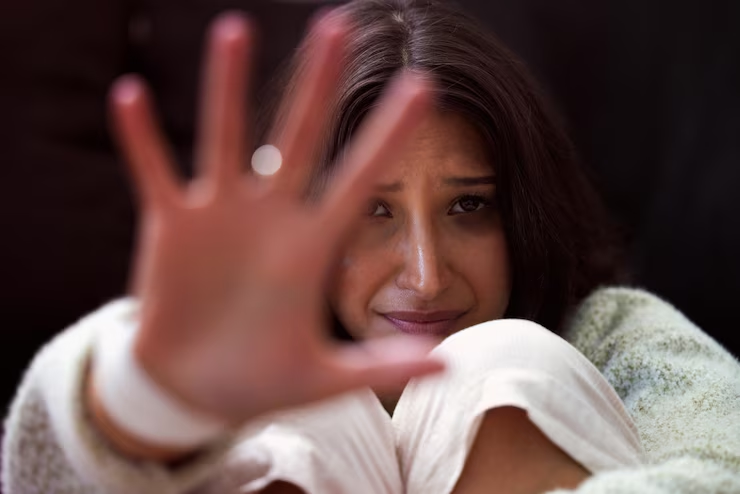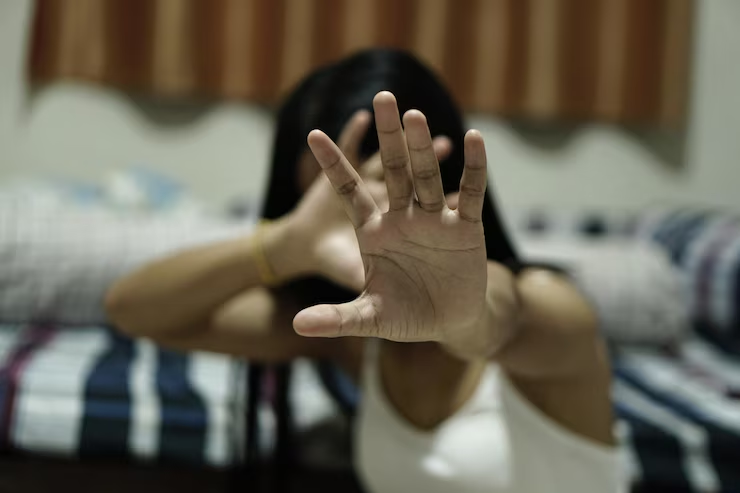Statistics are not just numbers; they tell stories of pain, survival, and loss. Every year, millions of women suffer at the hands of intimate partners or strangers, with an estimated 35% of women globally experiencing physical or sexual violence in their lifetime. Every second of every day, a woman somewhere lives in fear, her cries often unheard. For too long, I was one of those women. My story is not unique, but it is mine to tell.
A World Turned Dark.
It began with a slow erosion of self. At first, it was dismissive words, comments that made me second-guess myself. Then came isolation, subtle at first—“I think we should spend more time alone together; other people don’t understand us.” The emotional manipulation felt like water wearing away at stone. Before I realized it, I had become a shell of who I once was.
The turning point was a slammed door and a fist clenched in anger. I didn’t see it coming because I had convinced myself it never would. People like me don’t end up in abusive situations—or so I thought. But there I was, standing frozen in my own home, too scared to move, the sound of my own heartbeat deafening in the silence. The cycle of abuse had begun.
Living in Fear.
The fear was constant and suffocating. Every word I spoke was weighed and measured, every action carefully calculated to avoid triggering anger. But there was no rhyme or reason to what might set him off. A misplaced coffee cup or an innocent conversation could spiral into hours of accusations. I started to question my own sanity. Was it my fault? Was I the problem?

The nights were the hardest. The fear of what might happen if I didn’t respond the “right” way kept me awake. I became hyper-vigilant, reading every facial expression, listening to the tone of every word. I was living on edge, my body constantly in fight-or-flight mode. Even when I was alone, I felt his presence looming over me like a dark cloud.
The Isolation.
Abuse thrives in isolation, and I was no exception. Slowly, my friends stopped calling. It wasn’t that they didn’t care, but I had pushed them away without even realizing it. “He doesn’t like you talking to them,” I would explain. Or I would cancel plans at the last minute because it “wasn’t a good time.” Eventually, the invitations stopped coming.
My family tried to reach out, but I put on a mask, pretending everything was fine. “I’m just busy,” I’d say. I didn’t want them to worry, and I didn’t want to admit what was really happening. Admitting it would make it real. So I kept silent, letting the loneliness consume me.
The Breaking Point.
The first time he hit me, I couldn’t believe it had actually happened. The sting of his hand against my face was nothing compared to the sting of betrayal. I remember sitting on the floor, tears streaming down my face, wondering how I had let it get this far. But even then, I stayed. I told myself it was a one-time thing, that he didn’t mean it, that it would never happen again.
But it did. Again and again. The abuse became more frequent and more violent. I began to withdraw even further into myself, the shame and guilt eating away at me. I felt trapped, not just physically but emotionally. I was too scared to leave and too ashamed to ask for help.
The Hidden Scars.
People often think the physical wounds are the worst part of abuse, but it’s the emotional scars that cut the deepest. The constant belittling, the gaslighting, the way he made me feel like I was worthless—it broke something inside me. I stopped believing I was deserving of love or kindness.

I began to question everything about myself. Was I too sensitive? Too needy? Too much? He told me I was lucky to have him because no one else would put up with me. And for a long time, I believed him.
The Struggle to Survive.
Leaving was not a single moment of courage but a series of small, agonizing steps. Every attempt to break free felt like walking through fire. There were days when I thought it would be easier to stay. The uncertainty of what lay ahead was terrifying. But the alternative—continuing to live in fear—was no longer an option.
I’ll never forget the day I finally left. My hands were shaking so badly I could barely pack a bag. I kept looking over my shoulder, convinced he would catch me and drag me back. Every step felt like an eternity. But with each step, I felt a tiny flicker of hope ignite within me.
The Aftermath.
Leaving was just the beginning of a new kind of struggle. The trauma didn’t end when I walked out the door. Nightmares haunted my sleep, and flashbacks made it impossible to move forward. I struggled to trust people, to let anyone get close to me. I carried the weight of my past like a boulder on my back.
There were days when I thought I would never feel whole again. The fear and self-doubt lingered like unwelcome guests, and the loneliness was overwhelming. I felt invisible, like no one could see the pain I was carrying. But despite the darkness, I held on to the faint hope that things could get better.
A Promise of Hope.
This story is not about solutions, not yet. It’s about the reality of living through the epidemic of violence against women. It’s about the silent suffering that so many endure, the invisible wounds that take years to heal, and the strength it takes to simply survive. My journey wasn’t easy, and there were times when I wanted to give up. But I didn’t.

The solutions I found, the tools that helped me heal and rebuild my life, are a story for another time. For now, this is my truth. If you’re reading this and you see yourself in my words, know that you are not alone. There is hope, even in the darkest of times. You are stronger than you think, and you deserve a life free from fear and pain.
The Weight of Silence: A Continued Journey.
Every scar, whether seen or unseen, tells a story. And the story of what came after leaving was just as harrowing as the experience of living with violence. I thought freedom would feel like sunshine breaking through storm clouds, but instead, it felt like standing in a vast, empty field, unsure which direction to go. I wasn’t prepared for how the world would look at me, or worse, how I would look at myself.
The Long Shadow of Fear.
Even after I left, fear continued to grip my life. It was in the way I flinched when someone raised their voice, the way I avoided certain streets because they reminded me of him. Fear had seeped into my bones, and no matter how far I ran, I couldn’t shake it.
I remember walking into a grocery store for the first time after leaving and being overwhelmed by the crowd. My chest tightened, my palms grew sweaty, and I had to rush outside to catch my breath. It wasn’t just the fear of seeing him—it was the fear of being seen at all. I felt exposed, like everyone could see the pain I was carrying.
The Judgment of Others.
One of the hardest parts of the aftermath was facing the judgment of others. People asked questions like, “Why didn’t you leave sooner?” or “Why didn’t you tell someone?” They didn’t understand that leaving wasn’t as simple as packing a bag and walking away. It was a labyrinth of fear, manipulation, and survival.

Some people avoided me altogether, unsure of what to say. Others tried to help but ended up saying things that hurt more than they healed. “You’re strong; you’ll get over it,” they’d say, as if strength was something you could summon on command. The truth was, I didn’t feel strong. I felt broken, like I’d never be whole again.
The Battle with Shame.
Shame became my constant companion. It whispered in my ear that I was weak, that I had allowed this to happen, that I was somehow to blame. Even though I knew deep down that the abuse wasn’t my fault, the shame was relentless. It made me question my worth, my choices, my very existence.
I avoided mirrors because I couldn’t bear to look at myself. When I did, all I saw was a woman who had failed—failed to protect herself, failed to stand up for herself, failed to be the person she once was. The shame was a heavy weight, and carrying it alone felt impossible.
Finding My Voice.
For a long time, I didn’t talk about what happened. I was afraid of being judged, of not being believed, of being seen as “damaged.” But the silence was suffocating. It kept me trapped in the past, unable to move forward.
The first time I told someone my story, my voice shook so badly I could barely get the words out. But with every word, I felt a tiny piece of the shame lift. It didn’t happen all at once, and it didn’t make the pain disappear. But it was the first step toward reclaiming my voice, my power, and my sense of self.
The Struggle to Heal.
Healing wasn’t a straight path; it was a winding road filled with setbacks and obstacles. Some days I felt like I was making progress, only to be blindsided by a memory or a trigger that brought everything crashing down. I had to learn to be patient with myself, to accept that healing was a process, not a destination.

There were nights when the nightmares were so vivid that I woke up screaming. Days when the flashbacks were so intense that I couldn’t leave the house. I had to learn how to navigate a world that felt dangerous and unpredictable. It wasn’t easy, and there were times when I felt like giving up. But I didn’t.
A Glimmer of Light.
Over time, the darkness began to lift, little by little. It was in the small victories—the first time I laughed without feeling guilty, the first time I looked in the mirror and saw a survivor instead of a victim, the first time I went a whole day without feeling afraid. These moments were fleeting at first, but they grew stronger with time.
I started to rediscover parts of myself that I thought were lost forever. I remembered what it felt like to dream, to hope, to believe in a future that wasn’t defined by fear. The journey wasn’t easy, but it was worth it. Every step forward was a step toward reclaiming my life.
The Power of Resilience.
Looking back, I see the strength it took to survive, to leave, and to heal. At the time, I didn’t feel strong, but now I know that strength isn’t about never falling—it’s about getting back up, no matter how many times you’re knocked down. It’s about finding the courage to face your pain, to confront your fears, and to keep moving forward.
My story is not unique, but it is a testament to the resilience of the human spirit. For every woman who has faced violence, who has lived in fear, who has struggled to find her way out of the darkness, know this: you are not alone. Your pain is real, your journey is valid, and your strength is immeasurable.
This isn’t the end of my story—it’s just the beginning. But for now, I hope my words can serve as a light in the darkness for someone else. Because no matter how hopeless it may seem, there is always a way forward. You are not defined by what has happened to you. You are so much more than your pain. You are a survivor.
Reclaiming My Life: A Journey Beyond the Darkness.
The day I decided to reclaim my life wasn’t marked by a grand gesture or a sudden burst of courage. It was a quiet moment, sitting in my room, staring at the walls that had witnessed my pain. I had no plan, no clear vision of what lay ahead, but I knew one thing: I couldn’t keep living like this. The realization was terrifying yet liberating, the first step toward a freedom I hadn’t felt in years.
Taking the First Step.
The first step was admitting that I needed help. It was one of the hardest things I’ve ever done. For so long, I had convinced myself that I could handle it alone, that asking for help was a sign of weakness. But in that moment of vulnerability, I realized that seeking support was an act of strength.
I started small. I reached out to a local helpline that specialized in supporting women who had experienced domestic violence. My voice trembled as I spoke, but the person on the other end of the line didn’t judge me.
They listened, validating my pain and offering reassurance that I wasn’t alone. That call was a turning point, a lifeline that reminded me there were people who cared and wanted to help.
Finding Support.
Connecting with a support group was the next step in my journey. Walking into that room for the first time, surrounded by strangers who shared my experiences, was both terrifying and comforting.
We were all different, yet our stories were bound by a common thread of resilience and survival. Hearing others share their struggles and triumphs gave me hope. It reminded me that healing was possible, even if it felt out of reach.

In the group, I learned about the resources available to me, from counseling services to legal support. I started working with a counselor who helped me unpack the layers of trauma I had carried for so long.
Therapy was not a quick fix, but it became a space where I could confront my pain and begin to rebuild my sense of self. For the first time in years, I felt seen and heard.
Building a Safety Plan.
One of the most practical steps I took was creating a safety plan. It wasn’t just about leaving—it was about ensuring that I could do so in a way that prioritized my well-being.
With the help of a domestic violence advocate, I mapped out the steps I needed to take. I identified trusted friends and family members who could provide support, saved emergency contacts on a hidden phone, and gathered important documents in a safe place.
Having a plan gave me a sense of control that I hadn’t felt in a long time. It was empowering to know that I had options, that I wasn’t as trapped as I had once believed. The advocate also connected me with a shelter that provided temporary housing, a place where I could feel safe while I figured out my next steps.
Reclaiming My Independence.
Rebuilding my life meant reclaiming my independence, piece by piece. Financial abuse had been a significant part of my experience, leaving me with little control over my own resources. To address this, I worked with a financial counselor who helped me set up a bank account in my name and create a budget. It was daunting at first, but each small step was a victory.
Finding a job was another crucial step. It wasn’t easy—my self-esteem had been shattered, and I doubted my abilities. But with the support of my counselor and the encouragement of my support group, I began to believe in myself again. I started with a part-time position, and over time, I gained the confidence to pursue opportunities that aligned with my passions.
Learning to Trust Again.
One of the biggest challenges in my journey was learning to trust again. The wounds left by abuse made it difficult to let people into my life. I feared being hurt again, and I often questioned the motives of those around me. But healing required me to confront these fears and take small steps toward building healthy relationships.
I started by reconnecting with friends and family members who had supported me in the past. Their patience and understanding helped me feel safe and valued. Over time, I began to expand my circle, forming new friendships with people who respected my boundaries and celebrated my growth. Trust didn’t come easily, but it came gradually, one interaction at a time.
Rediscovering Myself.
The most profound part of my journey was rediscovering who I was outside of the pain. For so long, my identity had been tied to the abuse, but I was determined to reclaim my sense of self. I began exploring activities that brought me joy, from painting to yoga.
These moments of creativity and movement became a form of therapy, a way to reconnect with my body and mind.
Journaling became another powerful tool in my healing process. Putting my thoughts and emotions on paper helped me make sense of the chaos in my mind. It was a space where I could reflect on my journey, celebrate my progress, and set intentions for the future.
Through these practices, I began to see myself as more than a survivor—I was a person with dreams, talents, and a future worth fighting for.
Embracing a New Chapter.
As I continued to heal, I realized that my journey was about more than just surviving—it was about thriving. I wanted to use my experience to help others who were facing similar challenges.
I began volunteering with organizations that supported survivors of violence, sharing my story and offering a listening ear to those in need. Giving back became a source of strength and purpose, a way to turn my pain into something meaningful.
The Book That Changed Everything.
Throughout my journey, I sought guidance and inspiration wherever I could find it. One resource that profoundly impacted me was the book Breaking the Silence: Addressing the Epidemic of Violence Against Women.
This wasn’t just another book filled with generic advice—it was a lifeline, a guide that provided the practical tools and emotional support I needed to transform my life.
The book’s expert insights and compassionate tone resonated deeply with me. It helped me understand the dynamics of abuse, recognize my own worth, and take actionable steps toward healing. Every chapter felt like a conversation with someone who truly understood what I was going through. It wasn’t just a book—it was a companion on my journey.
If you or someone you know is struggling with the pain of violence, I cannot recommend this book enough. It offers a wealth of information and advice that can help anyone take the first steps toward freedom and healing.
You can find a digital copy of Breaking the Silence: Addressing the Epidemic of Violence Against Women at Libriffy.com. Don’t wait to start your journey—this book has the power to change lives, just as it changed mine.
Rebuilding with Purpose.
After discovering Breaking the Silence: Addressing the Epidemic of Violence Against Women, I felt as though a new chapter in my life had truly begun. The book was more than just words on a page; it was a blueprint for reclaiming not only my life but my sense of purpose.
Each lesson felt deeply personal, as though it was written specifically for someone like me—someone who had lost their way but was determined to find it again.
I began to implement the strategies and insights the book provided, starting with small, manageable steps. I remember reading the chapter on setting healthy boundaries and realizing how much power I had given away over the years.
Learning to say no, to protect my time and energy, was liberating. The book didn’t just tell me what to do—it showed me how to do it, breaking down each concept into actionable steps that I could apply in my everyday life.
Turning Pain into Power.
As I continued to heal, I found myself drawn to advocacy work. The book had ignited a fire within me to not only rebuild my own life but to help others do the same. I began volunteering at local shelters, sharing my story with women who were just beginning their journey toward freedom. It was humbling to see how much strength these women possessed, even in the face of unimaginable adversity.
The book emphasized the importance of building a community, and I took this advice to heart. I connected with other survivors and advocates, forming a network of support and solidarity.
Together, we organized workshops, awareness campaigns, and fundraisers to support survivors and educate the community about the realities of domestic violence. Turning my pain into power gave me a sense of purpose that I had never felt before.
Healing Through Education.
One of the most transformative parts of my journey was realizing the role that education played in my healing. The book offered an in-depth understanding of the patterns and dynamics of abuse, empowering me with knowledge that I could use to protect myself and others.
It was like a light bulb had been turned on, illuminating aspects of my experience that I hadn’t been able to articulate before.
I started attending seminars and training sessions on topics like trauma recovery, financial independence, and legal rights for survivors. Each new piece of information felt like a building block, helping me construct a stronger, more resilient version of myself.
The book’s guidance on continuing education and self-improvement inspired me to enroll in a program that aligned with my career goals, giving me the skills and confidence to pursue new opportunities.
Rediscovering Joy.
For so long, joy had felt like a distant memory, something reserved for other people. But as I worked through the book’s exercises and reflected on my progress, I began to rediscover what made me happy.
Simple things, like spending time in nature or listening to my favorite music, took on new meaning. I learned to appreciate the beauty in small moments and to celebrate even the smallest victories.
The book’s focus on self-care was a game-changer for me. It encouraged me to prioritize my mental and physical well-being, something I had neglected for far too long. I started practicing mindfulness and meditation, finding peace in moments of stillness. Exercise became a way to reconnect with my body, and journaling helped me process my emotions in a healthy, constructive way.
A Life Transformed.
The woman I am today is almost unrecognizable from the woman I was when my journey began. I no longer live in fear or doubt my worth. I am confident, empowered, and deeply committed to living a life that reflects my values and aspirations.
The journey wasn’t easy, and there were times when I felt like giving up. But every step forward was a testament to my resilience and determination.
The impact of Breaking the Silence: Addressing the Epidemic of Violence Against Women cannot be overstated. This book gave me the tools I needed to heal, the strength to move forward, and the inspiration to help others. It is a resource that I believe every survivor, every advocate, and every ally should have in their hands.
If you’re ready to take the first step toward healing, I encourage you to get a copy of this transformative book. You can find a digital copy at Libriffy.com. It’s not just a book—it’s a lifeline, a guide, and a companion for anyone who is ready to break free from the chains of violence and embrace a future filled with hope and possibility.
I am an accomplished author and journalist at Fact Finders Company . With a passion for research and a talent for writing, I have contributed to numerous non-fiction titles that explore a wide range of topics, from current events, politics and history to science and technology. My work has been widely praised for its accuracy, clarity, and engaging style. Nice Reading here at Fact After Fact.








